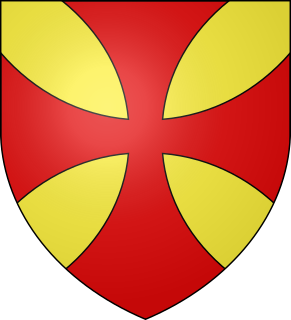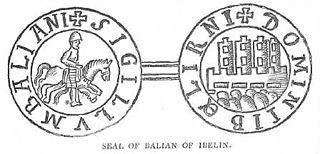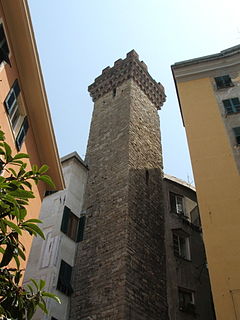Related Research Articles

Aimery of Lusignan, erroneously referred to as Amalric or Amaury in earlier scholarship, was the first King of Cyprus, reigning from 1196 to his death. He also reigned as the King of Jerusalem from his marriage to Isabella I in 1197 to his death. He was a younger son of Hugh VIII of Lusignan, a nobleman in Poitou. After participating in a rebellion against Henry II of England in 1168, he went to the Holy Land and settled in the Kingdom of Jerusalem.
Hugh III of Cyprus, born Hugues de Poitiers, later Hugues de Lusignan, called the Great, was the King of Cyprus from 1267 and King of Jerusalem from 1268. He was the son of Henry of Antioch and Isabelle de Lusignan, the daughter of king Hugh I of Cyprus. He was a grandson of Bohemund IV of Antioch and thus a descendant of Robert Guiscard.

Simon de Montfort, 5th Earl of Leicester, known as Simon IVde Montfort and as Simon de Montfort the Elder, was a French nobleman and famed knight of the early 13th century. He is widely regarded as one of the great military commanders of the Middle Ages. He took part in the Fourth Crusade and was one of the prominent figures of the Albigensian Crusade. Montfort is mostly noted for his campaigns in the latter, notably for his triumph at Muret. He died at the Siege of Toulouse in 1218. He was lord of Montfort-l'Amaury from 1188 to his death and Earl of Leicester in England from 1204. He was also Viscount of Albi, Béziers and Carcassonne from 1213, as well as Count of Toulouse from 1215.

The Crusader state of the Kingdom of Jerusalem, created in 1099, was divided into a number of smaller seigneuries. According to the 13th-century jurist John of Ibelin, the four highest crown vassals in the kingdom proper were :

The House of Ibelin was a noble family in the Crusader Kingdom of Jerusalem in the 12th century. They rose from humble beginnings to become one of the most important families in the kingdom, holding various high offices and with extensive holdings in the Holy Land and Cyprus. The family disappeared after the fall of the Kingdom of Cyprus in the 15th century.

Hugh of Ibelin was an important noble in the Kingdom of Jerusalem and was lord of Ramla from 1152-1169.

Baldwin of Ibelin, also known as Baldwin II of Ramla, was an important noble of the Kingdom of Jerusalem in the 12th century and was lord of Ramla from 1169-1186. He was the second son of Barisan of Ibelin, and was the younger brother of Hugh of Ibelin and older brother of Balian of Ibelin. He first appears in the historical record as a witness to charters in 1148.

Balian of Ibelin, also known as Barisan the Younger, was a crusader noble of the Kingdom of Jerusalem in the 12th century. He was lord of Ibelin from 1170-1193. As the leader of the defense of the city during the siege of Jerusalem in 1187, he surrendered Jerusalem to Saladin on October 2, 1187.

John of Ibelin, called the Old Lord of Beirut, was a powerful crusader noble in the 13th century, one of the best known representatives of the influential Ibelin family. The son of Balian of Ibelin and Maria Comnena, Queen consort of Jerusalem, he had close ties with the nobility of both Cyprus and Jerusalem, since he was the half-brother of Queen Isabella I of Jerusalem. Before he was 20, he was appointed constable of Jerusalem, and a few years later became lord of Beirut, where he rebuilt the city after Saladin's conquest, and established the grand Ibelin family palace. He served as regent for two of his young relatives, Isabella's daughter Maria of Montferrat from 1205 to 1210, and then Henry I of Cyprus from 1228 until Henry came of age in 1232. John was known as a principled man, and was seen as the natural leader of the Christian barons in the Holy Land. He resisted the power-seeking of Frederick II, Holy Roman Emperor, in Cyprus, and opposed the imperial forces until Henry came of age.

Philip Ι of Montfort, was Lord of La Ferté-Alais and Castres-en-Albigeois 1228–1270, Lord of Tyre 1246–1270, and Lord of Toron aft. 1240–1270. He was the son of Guy of Montfort and Helvis of Ibelin.
The Kingdom of Cyprus, as an offshoot of the Kingdom of Jerusalem, maintained many of the same offices, such as: seneschal, constable, marshal, admiral, Chamberlain, and chancellor.

Reginald Grenier was Count of Sidon and an important noble in the late-12th century Kingdom of Jerusalem.

Maria Komnene or Comnena was the second wife of King Amalric I of Jerusalem and mother of Queen Isabella I of Jerusalem.

House of Montfort was a medieval French noble house that eventually found its way to the Kingdom of England and originated the famous Simon de Montfort, 6th Earl of Leicester; although his father Simon de Monfort the Elder, leader of the French Crusaders during the Albigensian Crusade, is far more notorious in France and among military medievalists.
Balian I Grenier was the Count of Sidon and one of the most important lords of the Kingdom of Jerusalem from 1202 to 1241. He succeeded his father Renaud. His mother was Helvis, a daughter of Balian of Ibelin. He was a powerful and important representative of the native aristocracy during the three Levantine crusades of the first half of the thirteenth century.

The Embriaco were a prominent Genoese family, who played an important role in the history of the Crusader states. It also gave consuls, admirals and ambassadors to the Republic of Genoa.

Isabella of Ibelin (1241–1324), was Queen of Cyprus and Jerusalem by marriage to Hugh III of Cyprus.

Helvis of Ibelin was a daughter of Balian of Ibelin and his wife, Maria Komnene, who was the dowager Queen of Jerusalem. Helvis was a member of the House of Ibelin. She was Lady of Sidon by her first and second marriage.

Walter III, sometimes called Walter de Brisebarre or Walter Grenier, was the Constable of the Kingdom of Cyprus from 1206 and Lord of Caesarea in the Kingdom of Jerusalem from 1216. He was the eldest son of Juliana Grenier, Lady of Caesarea, and Guy de Brisebarre. Since he was witnessing royal charters by 1195, he must have been born no later than 1180. In the 1220s he was generally referred to as "the old lord of Caesarea", although probably only in his fifties. He took part in two Crusades and in two civil wars on the side of the House of Ibelin.
References
- The Encyclopædia Britannica:, Vol.18, Ed. Hugh Chisholm, 1911.